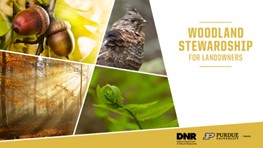Forestry & Natural Resources
FNR, Indiana DNR Introduce Video Series for Woodland Owners
Forests and woodlots are constantly changing. Just like a home, a little routine maintenance is required to keep them in good order. To get the most out of a property and to meet wildlife, recreational, aesthetic or economic goals, some type of regular management is necessary.
Getting the most out of their woodlands can be a challenge for individual landowners. The Indiana Department of Natural Resources Division of Forestry and Purdue Extension-Forestry and Natural Resources partnered together on the Woodland Stewardship for Landowners video series to help educate landowners on options for managing their woodlands.

This series includes videos about different forestry practices available to woodland owners, including information on their scientific basis, costs & benefits, and the general approach of each practice.
Ultimately, this will allow woodland owners to make more informed long-term management decisions that enhance their woods for their objectives.
“There is a lot of information out there about forest management, but not all of it is accurate,” Purdue Extension wildlife specialist Brian MacGowan said. “This video series will help landowners figure out which options are best for them and how to go about implementing them.”
Available videos include invasive species identification and removal (autumn olive, common buckthorn, Japanese barberry and privet), foliar spray, an introduction to both the Environmental Quality Incentives Program (EQIP) and sealed bid timber sales.
Additional videos discussing deer damage, single tree and patch cuts, and regeneration openings will be added to the series in the coming weeks.
“This video series provides Hoosiers practical woodland management information,” said John Seifert, state forester for the Indiana Department of Natural Resources. “We are proud of our partnership with the Purdue University Department of Forestry and Natural Resources (FNR), which made this production possible.”





